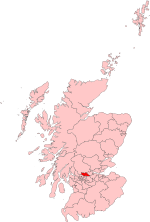Auchinstarry

Auchinstarry is a village in North Lanarkshire, Scotland, UK, near to Kilsyth. It is the site of a Roman fort. Auchinstarry Basin is on the Forth and Clyde Canal, and a £1.2M regeneration project has created a mooring basin for boats with 56 pontoon berths, a hard standing area for 40 boats, and a customer facilities block, partly funded by British Waterways Scotland. The basin was officially opened in September 2005. The Environment Advisory Service (EAS), a government agency, has implemented a number of sustainability features at Auchinstarry Basin: Deploying recycled materials in all parts of the construction process An innovative pump which draws heat from the canal; it is believed that this is the first such use of canal water in the UK Plans for installing wind turbines, and a new pub which is self-sufficient in its energy needs
Excerpt from the Wikipedia article Auchinstarry (License: CC BY-SA 3.0, Authors, Images).Auchinstarry
Smithstone Road,
Geographical coordinates (GPS) Address Nearby Places Show on map
Geographical coordinates (GPS)
| Latitude | Longitude |
|---|---|
| N 55.96 ° | E -4.05 ° |
Address
Smithstone Road
Smithstone Road
G65 9TR , South Barrwood
Scotland, United Kingdom
Open on Google Maps









